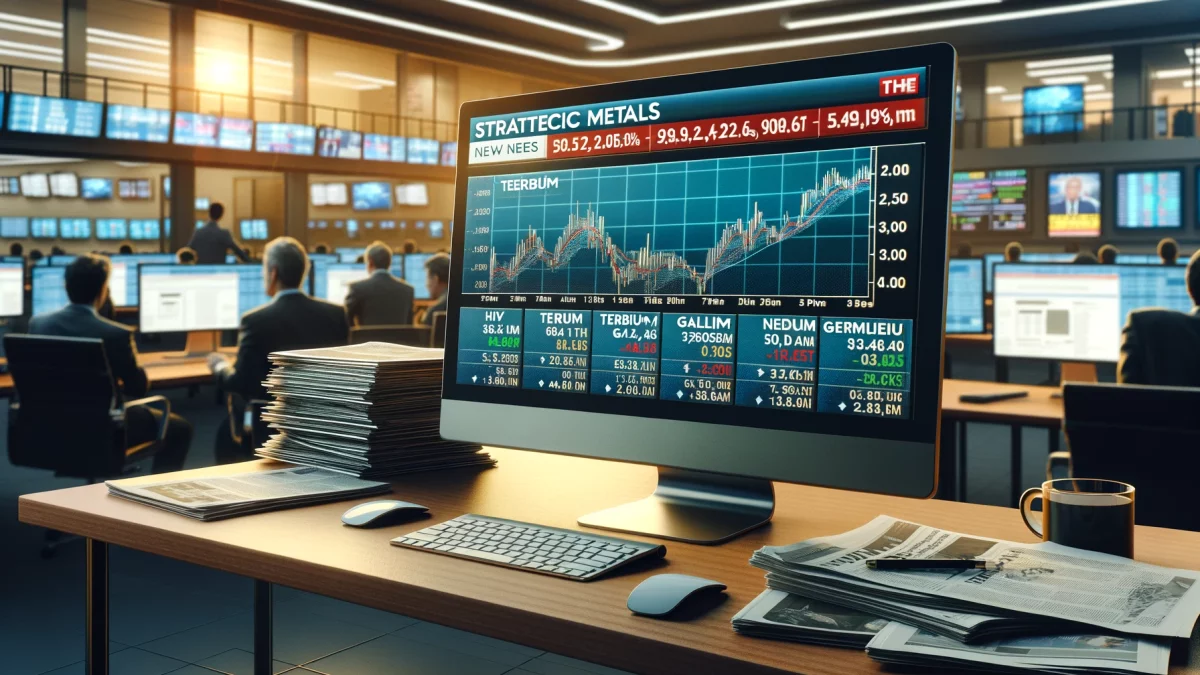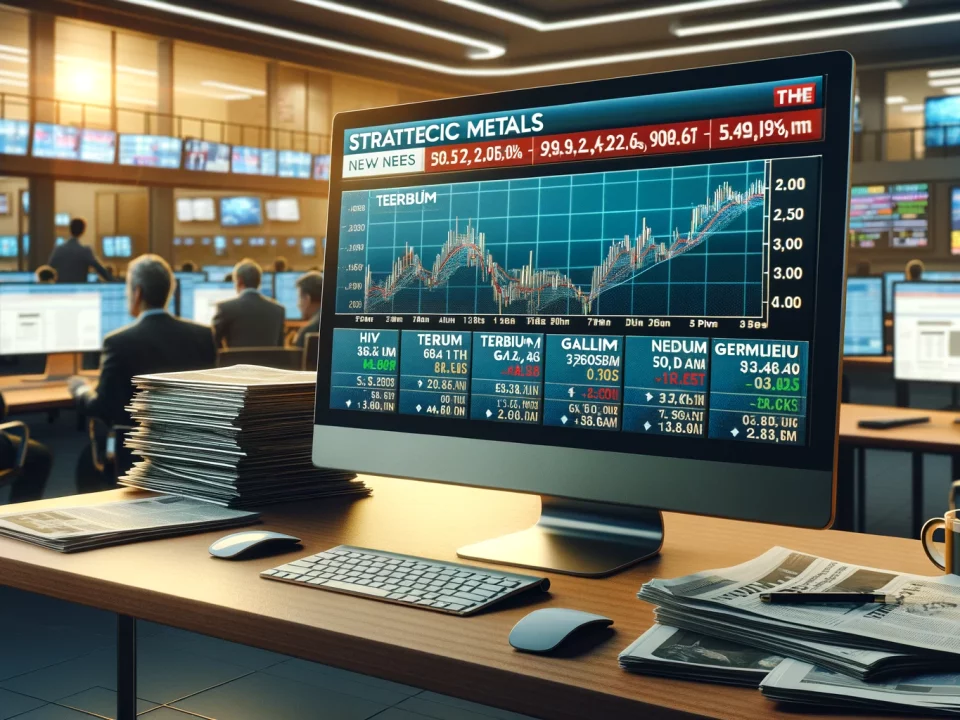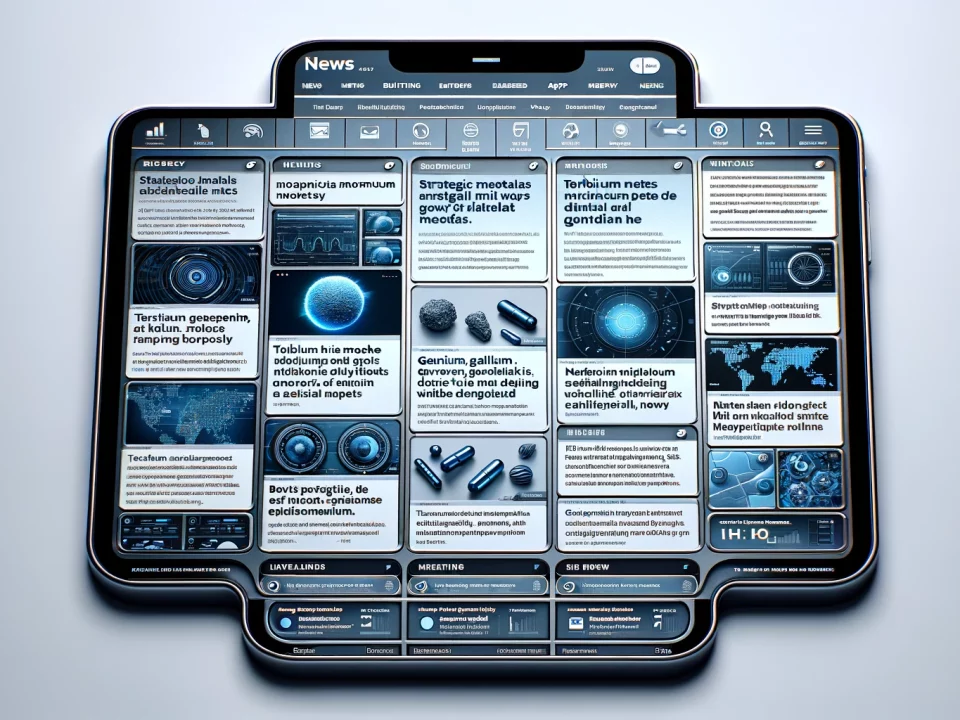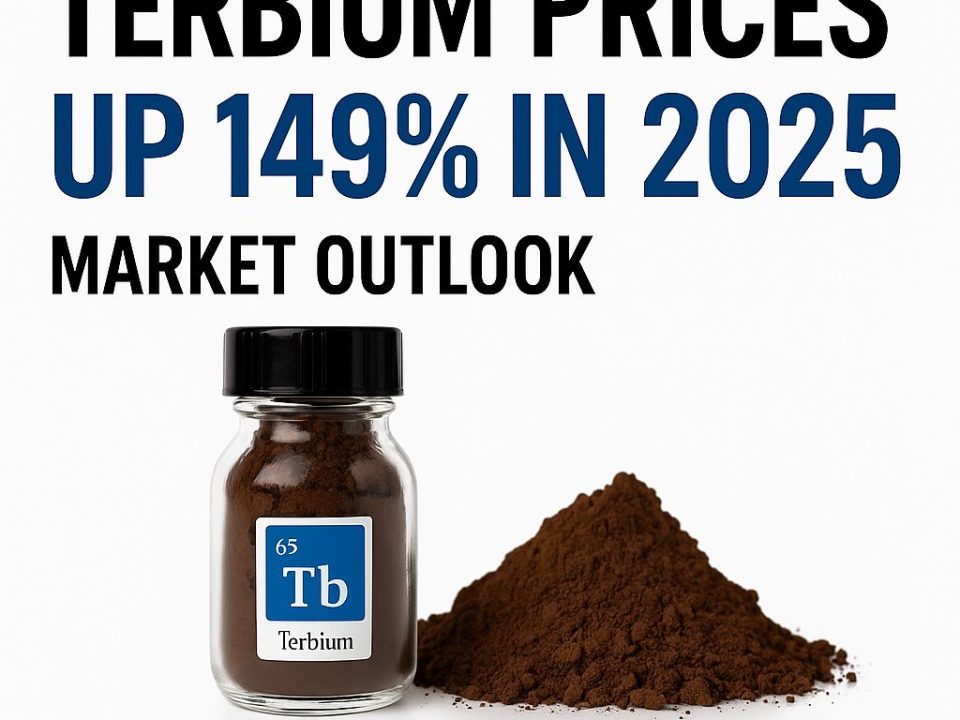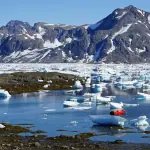
DEEP DIVE: Greenland’s Rare Earths
January 22, 2025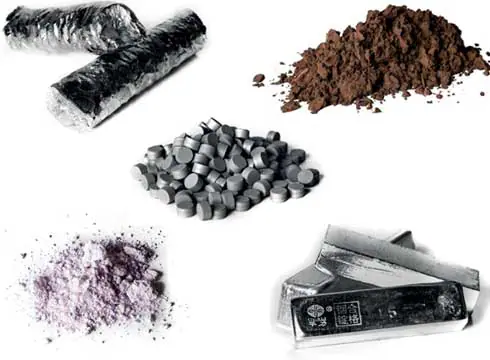
Why Strategic Metals Defy Market Logic (And How You Can Benefit)
February 1, 2025China released the second batch of export data for December this week, offering comprehensive insights for 2024. Meanwhile, two major players in the critical minerals mining sector, MP Materials and Iluka, published financial results for the fourth quarter.
All the news ahead in our weekly global new review.
CHINA EXPORTED MORE GALLIUM LESS GERMANIUM IN 2024:
According to data from the customs authority, in December, China exported 6,420 kilograms of Gallium, a decline of nearly nine percent compared to the same period in 2023. The only export destinations were Japan and South Korea.
For 2024, the world’s leading producer exported 69,440 kilograms of Gallium, representing a significant increase of over 55 percent. This is unsurprising, as China revised its export regulations in the summer of 2023, temporarily halting material shipment abroad. These restrictions have since been extended to include Germanium, for which data is also available.
In December, exports declined nearly ten percent compared to the same month last year, reaching 3,401 kilograms. The primary recipients were Belgium and Russia, with only 100 kilograms shipped to Germany, another leading destination. There was also a notable decline for the entire year compared to 2023, dropping by nearly 30 percent to 29,389 kilograms.
This development is partly because since the summer of 2023, no Germanium has been shipped to the USA, which was previously one of the largest recipients. Since December, exports of both Germanium and Gallium to the United States have been officially prohibited.
EU COMMISSION LAUNCHES STRATEGIC DIALOGUE ON THE FUTURE OF THE AUTOMOTIVE INDUSTRY:
This is a defining moment for the European automotive industry. The supply of raw battery materials is part of the potential agenda.
As part of its ongoing efforts to bolster the European automotive sector, the European Commission will hold a Strategic Dialogue on January 30th to secure the industry’s future. According to President Ursula von der Leyen, geopolitical tensions, global competition, and the complex transition toward decarbonization are challenging the sector and must be urgently addressed. The industry represents roughly seven percent of the EU’s GDP, with over 13 million people employed, highlighting its significance for the EU economy.
As part of a potential agenda, the Strategic Dialogue will focus on supplying raw materials essential for producing electric vehicles (EVs) and key automotive technologies, among other areas. The industry is undergoing rapid transformation; to stay competitive, the sector requires access to a steady, sustainable supply of critical raw materials like lithium, cobalt, and rare earth elements, which are key for manufacturing batteries and other advanced vehicle technologies.
Recycling will also be central to securing trade partnerships with resource-rich countries. Industry associations from Germany have recently called for action to strengthen the circular economy, underlining the importance of recycling for the whole economy (we reported).
In addition to securing access to raw materials, the dialogue will cover areas such as innovation, trade relations, optimization, and competitiveness. The dialogue will bring together manufacturers, suppliers, and other key stakeholders to discuss the European automotive industry’s challenges.
MEXICO AND EUROPEAN UNION ADVANCE FREE TRADE AGREEMENT:
Just before US President Donald Trump’s potential imposition of tariffs, negotiations that had been stalled for years gained new momentum.
The European Union and Mexico have resumed negotiations on a free trade agreement, reviving talks that had been stalled since 2020. The move came just before US President Donald Trump’s inauguration when he threatened tariffs on both regions. Previously, the EU and Mexico were bound by a 2000 trade agreement covering only industrial goods. The renewed discussions aim to expand the deal and address broader trade issues.
The new agreement aims to facilitate EU investments in Mexico, eliminate trade barriers like tariffs, and boost European agricultural products and food exports. The EU also seeks improved access to materials crucial for green and digital transformation. Mexico is the world’s largest producer of silver and a key supplier of gold, copper, zinc, and critical minerals like manganese. The country is also believed to hold significant, untapped reserves of rare earth elements.
The EU is heavily dependent on raw material imports.
As part of the 2024 Critical Raw Materials Act, the bloc aims to diversify its supply sources by 2030. The EU relies heavily on China to import essential resources like rare earth elements and Gallium. A recent trade agreement with Mercosur marked progress toward diversification (we reported). However, the new deal with Mexico must still be ratified before taking effect. The following steps involve presenting it to the EU member states for approval.
AUSTRALIA: RARE EARTH REFINERY CONSTRUCTION MAKING PROGRESS:
The resource company Iluka released its figures for the quarter ending December on Wednesday. The company, known for its specialization in titanium and zirconium, reported a decline in revenue for both the quarter and the full year. However, promising news is emerging from its emerging third focus area: the mining and processing of rare earths.
In Western Australia, Iluka plans to build the nation’s first fully integrated rare earth refinery, which is estimated to cost just over one billion US dollars.
The project is partially financed through an Australian government loan. Once operational, the refinery will process raw materials sourced from Iluka’s own mining operations and third parties into rare earth oxides. These oxides are essential for manufacturing magnetic alloys and critical in producing components for wind turbines, electric vehicles, and other advanced technologies. The refinery in Eneabba is scheduled to begin operations in 2027.
CHILE AIMS TO LEVERAGE NEW STRATEGIC METALS RESOURCES:
Untapped resources, including rare earth elements, lie hidden within the nearly 800 waste piles across the South American country.
Mining plays a significant role in Chile, which holds some of the world’s largest reserves of copper and lithium. These metals rank first and second in global production, respectively. In addition to extracting these vast mineral resources, the country is now focusing on repurposing the legacies of centuries of mining activity.
According to industry reports, Chile’s Ministry of Mining aims to manage the nearly 800 waste piles more sustainably, reduce environmental impacts, and recover valuable materials through a new initiative. The remnants of past mining often still contain essential resources like cobalt and rare earth elements—materials that were once economically unviable but are now in high demand for rapidly growing sectors such as renewable energy.
Chile’s national development agency Corfo plans to invest approximately $3 to $4 million per project over the next three years, as reported by Mining.com. Proposals for tenders can be submitted in March.
“The world needs critical minerals, and at the same time, Chile needs solutions for recycling and remediating its mining legacy,” said Patricio Aguilera, national director of Chile’s Geological Service Sernageomin. According to government data, Chile has 795 waste piles, of which 60% are inactive, 22% are abandoned, and only 16% are still in operation.
CHINA: RARE EARTH MAGNET MAKER JL MAG TO BUILD NEW FACILITY –
The plant will boost the company’s total output by 50 percent.
On Tuesday, Chinese magnet producer JL Mag announced plans to construct a new production facility worth $143.6 million (CNY1 billion). According to the state-affiliated Chinese news outlet Yicai, the plant will be in Baotou, within the Inner Mongolia Autonomous Region. This would help streamline supply chains as Baotou is also home to one of China’s rare earth mining hubs, including the world’s largest rare earth mine, Bayan Obo. The plant will have an annual production capacity of 20,000 tons of magnetic rare earth material, boosting the company’s total capacity by 50 percent. Construction is estimated to take two years.
JL Mag is one of the world’s largest producers of rare earth magnets, serving key industries such as automotive manufacturing, air conditioning, and the wind power sector. As the world’s leading player, China accounts for approximately 90% of global rare earth magnet production, leaving the rest of the world heavily reliant on imports of these key components. To address this imbalance, other countries are stepping up efforts to diversify supply chains and reduce dependency on China.
For instance, Brazil recently began developing South America’s first magnet production facility. Additionally, Neo Performance Materials, a Canadian critical minerals company, is building a magnet manufacturing facility in Estonia.
USA: MP MATERIALS BEGINS COMMERCIAL OPERATIONS AT MAGNET FACILITY IN TEXAS –
Rare earth metal is in production, and the finished magnets are in trial production.
MP Materials, the operator of the only active rare earth mine in the United States, has officially commenced commercial production at its magnet manufacturing facility in Fort Worth, Texas. The company announced that it has successfully started large-scale production of neodymium-praseodymium (NdPr) metal, a precursor material for neodymium-iron-boron (NdFeB) magnets, for which it also completed initial trial production. These magnets are critical for high-tech industries such as electric vehicles, robotics, and consumer electronics.
Once fully operational, the facility is expected to produce approximately 1,000 metric tons of finished magnets annually, using feedstock from its mine in Mountain Pass, California, according to the company. Among its key customers is US automaker General Motors, which plans to incorporate these magnets into its electric vehicle models.
China Dominates Global Production:
China dominates global rare earth magnet production, accounting for 90% of the market. Companies like MP Materials are working to reduce this dependency, but the challenge remains significant. In 2024, the US imported approximately 7,446 tons of magnets from China, according to customs data, highlighting that a single facility cannot fully offset this imbalance.
German magnet manufacturer Vacuumschmelze is another player aiming to enter the US market. The company is constructing a new magnet production facility in South Carolina, scheduled for completion in late fall 2025. This will further bolster US efforts to diversify its supply chain (we reported).
However, the entire value chain from mine to magnet is still incomplete. In addition to rare earth elements, the base alloy primarily consists of iron, with boron added to the mix. The alloy undergoes multiple reshaping processes under pressure and heat before being magnetized.
EUROPE: PROGRESS ANNOUNCED ON EU PROCUREMENT PLATFORM FOR STRATEGIC METALS –
Momentum is building around developing a platform for consolidating critical raw materials for European industries. According to an exclusive report by Reuters, consulting firm PriceWaterhouseCoopers and a Slovak software company have been commissioned to establish the system.
The platform is set to include materials like rare earths and lithium, as well as hydrogen and other energy products. Reuters also reported in October that eight companies participated in the EU’s tender process.
The Critical Raw Materials Act (CRMA) proposed the creation of a joint procurement system. This EU legislation, aimed at securing critical raw material supplies, came into force in May 2024. The initiative takes inspiration from the gas procurement platform launched in the spring of 2023 to mitigate the impact of the Ukraine war on the energy market.
However, skepticism has emerged in the mining industry since CRMA was adopted. Critics argue that individual companies’ procurement requirements are too diverse to accommodate a unified approach. Benedikt Sobotka, then CEO of Eurasian Resources Group, voiced these concerns in an interview with the Financial Times.
US DEPARTMENT OF ENERGY ANNOUNCES PROGRESS ON NEW UPCYCLING PROCESS OF WASTE PLASTICS:
Researchers are developing a new recycling method to enhance material value with new properties.
Plastic pollution is one of the world’s most pressing issues. According to the OECD, only nine percent of global plastic waste was successfully recycled in 2022. The rest is either incinerated, in landfills or pollutes the oceans. By 2040, the amount of improperly disposed plastic could increase drastically. Expanding recycling efforts faces several challenges, including economic viability and the often lower quality of recycled materials.
Researchers at the Oak Ridge National Laboratory (ORNL) of the US Department of Energy have developed a method to make recycled materials even more valuable by altering their properties. The key lies in modifying the polymers found in discarded plastics—chemical compounds made up of smaller molecular units. This process utilizes an existing technique called Molecular Editing, which has been recognized with two Nobel Prizes in Chemistry, including one in 2020 for the invention of CRISPR technology, also known as “gene scissors.”
“Their process is like CRISPR for polymers,” explains Jeffrey Foster, the lead researcher at ORNL. Compared to traditional recycling, where plastic is usually melted down with the hope of achieving a “good result,” this method is much more targeted, allowing nearly all the material to be recovered. Additionally, it saves energy and reduces emissions.
Ruthenium: A Valuable Aid in Plastic Upcycling –
The materials are first dissolved in solvents. A ruthenium catalyst is used to facilitate the subsequent formation of polymers. According to the researchers, these catalysts are already employed in the industry to produce robust plastics and convert biomass into fuels, indicating significant potential for chemical upcycling. By altering the composition of the polymer building blocks, it is possible to determine how strong, soft, or heat-resistant the recycled plastics will be. Manufacturing materials previously used for a single product could ultimately find new purposes in different categories.
In developing their method, the ORNL team focused on widely used polymers that significantly contribute to global plastic waste. For example, they worked with soft polybutadiene, commonly found in rubber tires, and acrylonitrile-butadiene-styrene, used in plastic toys, computer keyboards, ventilation pipes, and kitchen appliances.
Foster says recycling for these waste streams has been virtually non-existent until now. The goal is to extend the concept to a wide range of industrially important polymers, thereby increasing economic viability. As a result, a circular economy, where waste materials are reused instead of disposed of, could become much more realistic.
CANADA: RARE EARTH RECYCLER SECURES ADDITIONAL MULTI-MILLION INVESTMENT –
The Canadian rare earth recycler Cyclic Materials has secured another significant financial boost. According to a press release, InMotion Ventures, the investment arm of automaker Jaguar Land Rover, will invest $2 million in the startup. This contribution raises Cyclic’s Series B funding round—designed to support growth and expansion—to $55 million.
With this funding, Cyclic plans to accelerate the launch of its first commercial facilities in the United States and Europe. The company specializes in extracting rare earth elements from end-of-life products such as consumer electronics, EV drive motors, and medical devices. Currently, less than 1% of these critical materials are recycled, despite increasing demand and efforts by many countries to reduce reliance on imports from China, the dominant global supplier.
To support the diversification of supply chains, Cyclic collaborates with other Western players, including Solvay’s rare earth facility in France and Ucore Rare Metals in Canada. The startup’s existing investors include major corporations such as Microsoft, Hitachi, and BMW. Cyclic has also received funding from the Canadian government.



